At its simplest, a comic book is a visual medium used to express ideas via images, often combined with text and presented in a sequential manner to form a narrative that may or may not be humorous. According to ‘A Brief History of Comic Books’, by John Petty, “Many comics historians point to European broadsheets of the sixteenth century as the ancient precursors of comic books, or satirical magazines of the 1780s.” Arguably the art form has a pre-history that goes as far back as the Lascaux cave paintings.
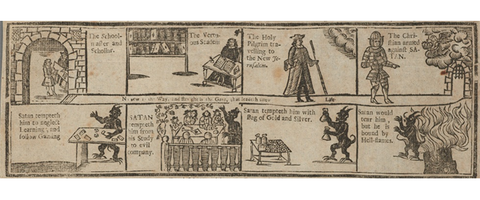
The genre as we would recognise it today was first popularised in the United States and emerged as a mass medium in the early 20th century with the advent of newspaper comic strips. Magazine-style comic books followed in the 1930s. They were originally aimed at the semi-literate working class, and eventually came to be seen as childish; hence they were marketed towards children.
The exhibition ‘Comics Unmasked: Art and Anarchy in the UK’ at The British Library traces the British comic book tradition back through classic 1970s titles to 19th century illustrated reports of Jack the Ripper and beyond. The top three longest running comics in the world are all British. ‘The Dandy’ began in 1937 and ‘The Beano’ (which is still going today), in 1938.
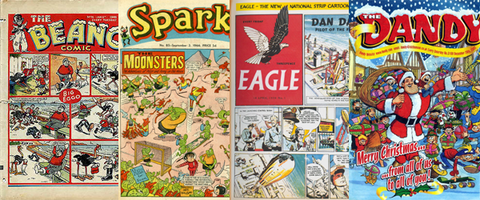
Comic Book Art has long been a medium that challenges categorisation, preconceptions and status quo, uncompromisingly addressing politics, gender, violence, sexuality and altered states. In the late 1960s and 1970s, the underground comics movement inspired two new publications in Britain; ‘Oz’ and ‘Nasty Tales’, which were launched with the premise of counter-culture rebellion. ‘Oz’ notoriously features the children’s character Rupert the Bear performing sexual acts and both comics were tried at the Old Bailey under the Obscene Publications Act.
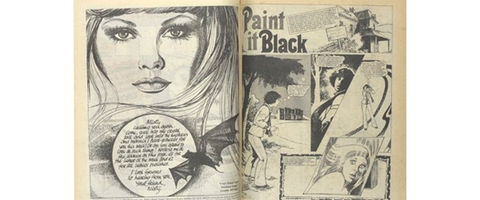
Typically occupying the fringes of pop culture, the comic book is much more than a form of entertainment for children, it can be a “serious and sophisticated art form that both feeds off of and creates cultural formulas and historical constructs.” It’s not surprisingly therefore, that serious and sophisticated artists have both created comic book art and been inspired by iconic British comics.
The irreverent themes and flouting of authority explored in comic books wonderfully echoes some of the key tenets of Pop Art; flouting the rules of the fine art establishment. Pop Art emerged in the mid-1950s in Britain, presenting a challenge to the traditions of Fine Art by appropriating imagery from popular culture. Pop Art appropriated aspects of mass culture, such as advertising and comic books to both celebrate and scrutinize popular culture. The Godfather of British Pop Art Sir Peter Blake, led the way and he has been exploring imagery from magazines, fanzines and comics ever since.
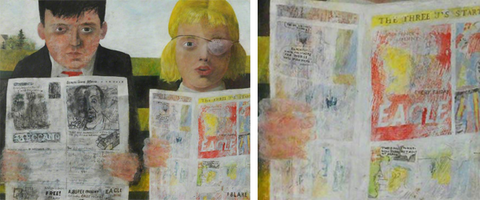
In 1954, Peter Blake painted ‘Children Reading Comics’. The oil painting was based on a snapshot of himself and his sister, Shirley, reading ‘The Eagle’ comic. Shirley has the first choice of the coloured front and back pages with their exciting strip cartoons, whilst Peter is having to make do with the black and white inside pages. Many regard this painting as Peter Blake’s first Pop Art painting because it focuses on the popular ephemera of modern life, namely ‘The Eagle’ comic.
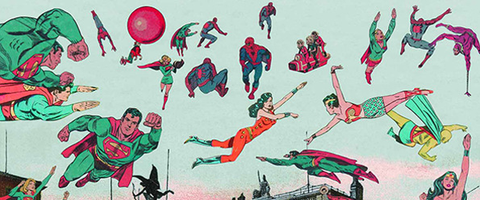
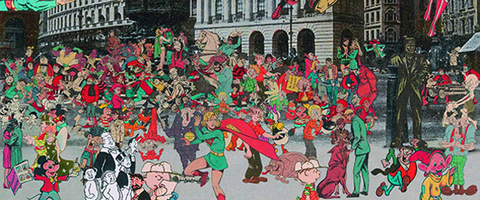
60 years later, Peter Blake continues to be inspired by classic comic book imagery. In 2012 he created ‘The Convention of Comic Book Characters’, a spectacular collage of US and UK comic book characters descending on London’s Piccadilly Circus. This year he has collaborated with ‘The Beano’ to create an extra special limited edition print celebrating the 75 years of the iconic British comic. The print is a fantastic collage of cut-out mischievous comic strip characters, including all of the Beano favourites such as Dennis the Menace, Gnasher, Billy Wizz, Lord Snooty and Minnie the Minx.
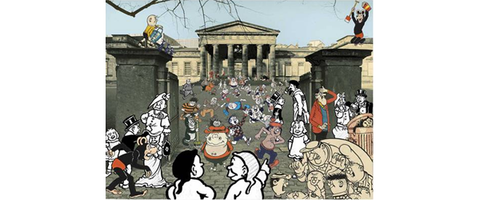
The poster for the ‘Comics Unmasked’ exhibition at the British Library has been designed by fellow artrepublic artist, Jamie Hewlett. The British comic book artist and designer has created original artwork and a video montage for exhibition, saying, “There’s no national institution better than the British Library to showcase such an extensive collection of British comic art. I’m thrilled to part of this exhibition, and to celebrate the history of British comics.”
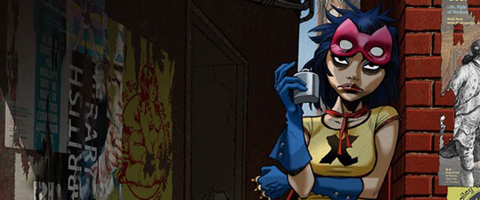
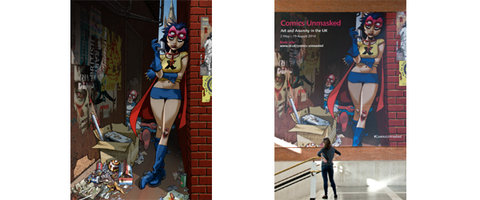
According to an interview in the Guardian with Mark Kermode, Jamie Hewlett’s first loves were the cartoons of Chuck Jones, particularly ‘Daffy Duck’, ‘Wile E Coyote’ and ‘Pepé Le Pew’. At the age of nine he drew a strip cartoon version of Star Wars, which became his first graphic novel. At Northbrook Art College in Worthing, Hewlett, worked with two friends to produce a fanzine called ‘Atomtan’, a post-punk comic. His big break came in 1988 with the launch of ‘Deadline’, an edgy magazine blending articles on music and culture with comic strips. The magazine's star was Tank Girl, a spunky post-apocalyptic heroine with a kangaroo boyfriend who became an international cult.
‘Tank Girl’ made Jamie Hewlett a star, a leading light of the new-wave comic book industry. Since then he has won the Design Museum’s ‘Designer of the Year’ award for his work on Gorillaz and collaborated with David Albarn on the set and costume designs for the acclaimed Chinese opera ‘Monkey: Journey to the West’. Hewlett’s comic book work has influenced his impressive range of limited edition prints, moving his visual output from the comic book pages to the gallery wall.
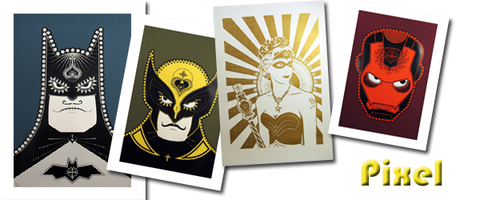

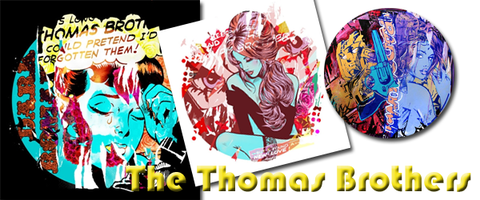
You can find the influence of comic book imagery throughout our collections, from Roy Lichtenstein museum prints to limited editions by Pixel, The Thomas Brothers and Pure Evil. In some cases the artists have appropriated ideas and imagery found in cartoons - such as David Spiller’s portraits of iconic characters like Pluto, Sylvester J. Pussycat, and Pinocchio. In other cases cartoonists like Simone Lia have transformed their comic book imagery into fine art prints. What is evident is the far-reaching long-lasting influence of British comics!
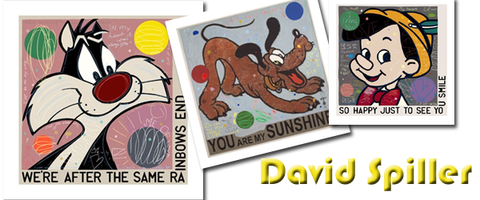
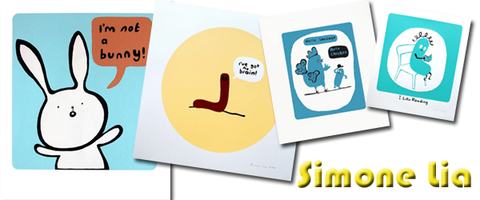
Happy 75th birthday to The Beano from everyone at artrepublic!
Credits:
‘A Brief History of Comic Books’ by John Petty
‘The Year of the Monkey’ by Mark Kermode in The Guardian
Image Credits:
Detail of panels from The Young-Mans Victory Over the Povver of the Devil Or Strange and VVonderful News from the City of London (?1693).
Page from Misty, the 1970s comic book of supernatural and horror stories. Photograph: British Library Board